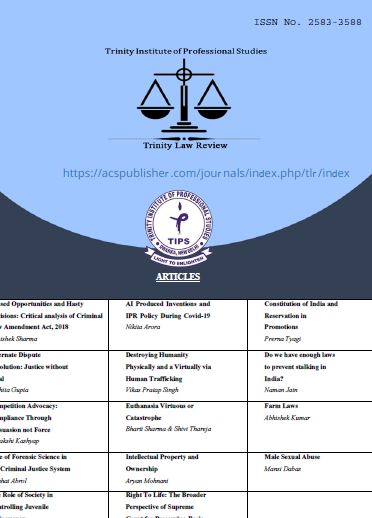Author Guidelines
Authors can submit their work for publication after online Registration with the website link given below
GUIDELINES FOR SUBMISSIONS
All submissions should be sent with a covering letter indicating the Name of the Author, Institutional Affiliation, Contact Details and the Topic of the paper.
- We allow a maximum of two authors. Co-authored papers should give details about both the authors.
- The Editorial Board will consider the authorship and designation mentioned in the cover letter during submission as final and correct, unless otherwise intimated by the author/s. It shall be the responsibility of the Author to intimate the Editorial Board regarding any change in designation during the period in which the paper is being processed. No changes will be entertained after publication
- The Author must send a duly signed and dated copy of Annexure 1 (attached below), along with the submission.
SCREENING PROCESS
The (NAME OF JOURNAL) Editorial Team works tirelessly to maintain the standards of the (NAME) Journal. Each draft is screened thoroughly in three phases to ensure this:
- An initial Internal Screening is conducted to ensure that the drafts submitted fulfill general appropriateness of work and the foundation of the paper is conceptually and theoretically fit. At this stage, the team also makes sure that the draft meets the basic requirements in terms of citation style, formatting, word limits etc.
- The drafts then undergo Plagiarism Test; the maximum limit of similarity index allowed is 10%. The Authors are requested to make sure that this criterion is fulfilled before submission.
- Subject to the above two tests, the approved drafts are then sent to an expertfor Blind Peer Review. The expert evaluates the draft on various parameters, such as relevancy of topic, comprehensiveness, original contribution to existing knowledge, language, coherence etc., and the review report is shared with the author.
The whole process takes a minimum of at least 6 to 8 months depending on the influx of submissions. The Authors will be intimated at the end of each stage if modifications are required in the original draft. Final acceptance or rejection is subject to the above 3 tests.
TEXT FORMAT
The length of the manuscript should average as follows (all inclusive of footnotes):
▪ For Article – 6000 to 12000 words
▪ All Others(Case Comment/Book Review/Bill comment/Legislative comment etc.) – 2000 to 6000 words
Manuscripts shall be formatted according to the following guidelines.
- It shall include an abstract of not more than 150 words.
- All citations shall be placed in foot-notes.
- Number less than 100 shall be spelt out unless they are a percent (e.g., 5percent). • Use of first person shall be avoided.
- All pages shall be numbered.
- Uniform date format shall be used (e.g., August 15, 1947).
- Quotations: Quotations within a sentence must be enclosed in double quotation marks (“ ”). A quotation within a quotation should be enclosed in single quotation marks (‘ ’).
- A quotation longer than three lines should be set out in a separate block indented from both the left and right margins. Do not enclose the quotation in quotation marks. A quotation is introduced with a colon (:), followed by reference in footnote.
- When referring to a section or article of a statute in the main text, the word ‘section’/’ article’ should neither be abbreviated nor capitalized. However, in the footnotes the section/ article should be abbreviated.
E.g. the Constitution of India, art. 30; the Indian Penal Code, s. 42.
USE OF FOOTNOTES
(NAME OF THE JOURNAL) prefers footnotes (to end notes) because of the following reasons:
- To identify the source of quotations or paraphrases;
- To acknowledge indebtednessfor words, phrases or ideas borrowed;
- To explain where additional evidence or commentary may be found;
- To provide additional material or discussion that is relevant but which would disrupt the flow of the text if it were included in the main text itself;
- To refer the reader to other parts of the paper; and
- To enable the reader to read the reference without having to turn to the end of the text which would otherwise tend to disrupt the flow of the text and hamper smooth reading.
CITATION FORMAT
The Institute has formulated a set pattern of citation (i.e., ILI Rules of Footnoting), which is followed in (NAME OF THE JOURNAL) and various other publications of the Institute
ANNEXURE 1
Declaration
- I have read, understood and agreed to the submission guidelines, policies and Submission declaration of the journal.
- I confirm that all authors of the manuscript have no conflict of interests to declare. 3. I confirm that the manuscript is the authors' original work and that the paper now Submitted is not copied or plagiarized version of some other published work. 4. I confirm that the manuscript has not received prior publication and is not under consideration for publication elsewhere and I shall not submit the paper for publication in any other Journal or Magazine till the decision is made by journal Editors.
Name & Signature: Place:
Date:





